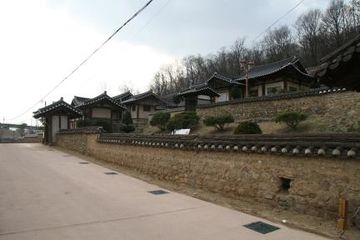안동 임청각
| 안동 임청각 Imcheonggak House, Andong |
|
 안동 임청각, 국가문화유산포털, 문화재청. |
|
| 대표명칭 | 안동 임청각 |
|---|---|
| 영문명칭 | Imcheonggak House, Andong |
| 한자 | 安東 臨淸閣 |
| 주소 | 경북 안동시 임청각길 53 (법흥동) |
| 지정(등록) 종목 | 보물 제182호 |
| 지정(등록)일 | 1963년 1월 21일 |
| 분류 | 유적건조물/주거생활/조경건축/누정 |
| 시대 | 조선시대 |
| 수량/면적 | 1동 |
| 웹사이트 | 안동 임청각, 국가문화유산포털, 문화재청. |
|
|
|
해설문
국문
임청각은 형조좌랑을 지낸 이명(李洺)이 1519년에 지은 집이다. ‘임청각’은 중국의 시인 도연명이 지은 「귀거래사(歸去來辭)」 중 “동쪽 언덕에 올라 길게 휘파람 불고, 맑은 시냇가에서 시를 짓기도 하노라.”*는 구절에서 임(臨)과 청(淸) 두 글자를 따왔으며, 현판은 퇴계 이황이 직접 썼다. 건물 앞을 흐르는 낙동강과 영남산 자락에 터전을 잡은 건물이 자연환경과 잘 어울린다.
임청각은 안채와 중채**, 사랑채, 행랑채, 사당, 별당 등으로 이루어졌으며, 원래는 99칸의 대저택이었다고 한다. 그러나 1942년 일제가 불온한 조선 사람이 많이 나온 집이라 하여 임청각 마당을 가로질러 중앙선 철로를 만들면서 50여 칸의 행랑채와 부속 건물이 헐려 현재는 50여 칸이 남아 있다.
임청각은 용(用)자가 가로 누운 듯한 평면 구성으로 되어 있다. 남녀와 계층별로 공간을 뚜렷이 구분하여 위계질서를 분명히 한 것이다. 군자정(君子亭)은 ‘丁’자 모양의 누각으로 된 별당 형식으로 된 건물이다. 정자 안에는 이곳을 찾은 농암 이현보, 제봉 고경명, 백사 윤훤, 송강 조사수가 지은 시들이 걸려 있다.
임청각을 지은 이명의 할아버지 이원(李原, 1368~1429)은 조선 초 태종이 왕자의 난을 평정하고 왕위에 오르는 데 협력하여 공신이 되었으며 세종 때 좌의정을 지냈다. 이러한 선조의 공훈을 인정받아 이명은 과거를 거치지 않고 관직에 나갔으며, 갑자사화 당시에 유배되었다가 1506년 중종이 즉위한 이후 풀려나 의흥(지금의 군위 지역)의 지방관을 지냈다. 벼슬하는 동안에는 어진 사람으로 이름이 높았고, 이후 고향인 안동으로 돌아가 임청각을 짓고 풍류를 즐겼다.
임청각은 이명의 후손이며 일제강점기 독립운동가이자 대한민국 임시정부의 초대 국무령을 지낸 석주 이상룡(石洲 李相龍, 1858~1932)이 태어난 집이다. 이상룡은 일본에 나라를 빼앗긴 이듬해 임청각을 팔아 독립 자금을 마련하였고, 만주에 신흥무관학교를 세워 독립군을 양성하였으며, 독립운동단체의 통합을 주도하는 등 평생을 독립운동에 힘썼다(전문가의 확인 필요).
- 등동고이서소(登東皐以舒嘯) 임청류이부시(臨淸流而賦詩)
- 중채 : 안채와 사랑채 사이에 있는 집채
영문
Imcheonggak House, Andong
This house was built in 1519 by Yi Myeong, a civil official of the Joseon period (1392-1910). It is also the birthplace of Yi Sang-ryong (1858-1932), the first prime minister of the Provisional Korean Government during the Japanese colonial period (1910-1945). Although it was partially destroyed, this house is one of the oldest extant upper-class residences in Korea.
Yi Myeong’s grandfather, Yi Won (1368-1429) was honored as a meritorious subject for assisting King Taejong (r. 1400-1418) during a power struggle for the throne. He also served as second state councilor during the reign of King Sejong (r. 1418-1450). Due to his grandfather’s achievements, Yi Myeong was allowed to serve as a government official without taking the state examination. He served as assistant section chief of the Ministry of Punishments, but was exiled during the Literati Purge of 1504. In 1506, he was reinstated as a local official of Uiheung (today’s Gunwi area). He later retired to Andong, his hometown, where he built this house. The house underwent various repairs over the centuries. In 1911, it was sold by Yi Sang-ryong to raise funds for the anti-colonial independence movement. Yi then moved to Manchuria where he established a martial arts school and devoted his life to independence activities.
When this house was first built, it was a massive complex with six buildings, which was the maximum number allowed for the nobility. The Nakdonggang River was directly in front of the house and the Yeongnamsan Mountain was behind it, which was the ideal layout according to Korean feng shui theory. But, in 1942, the Japanese authorities spitefully built a railway right through the front of the historic house, destroying half of it, due to its connection with so-called “rebellious Koreans.”
The remaining buildings include a main quarters consisting of an outer servant’s quarters, inner servant’s quarters, woman’s quarters, and men’s quarters, as well as a shrine and a pavilion named Gunjajeong (“Pavilion of the Gentleman”). The main quarters has a complex design with five courtyards. The servant’s quarters are along the front and left, the women’s quarters is in the rear center, and the men’s quarters is in the rear right. The pavilion, to the right of the main quarters, is separated by a stone wall. It is shaped like the letter T and has a pond next to it. In the far rear right of the complex is the family’s ancestral shrine.
The name Imcheonggak means “Hall the Overlooks Clarity” and comes from a line in a poem by the Chinese poet Tao Yuanming (365-427) that reads, “I climb the hill on the east and whistle for a while; Sitting beside the clear water, I also compose poetry.” The house’s name plaque was calligraphed by the renowned scholar Yi Hwang (1501-1570).
영문 해설 내용
임청각은 조선 전기의 문신인 이명(李洺)이 1519년에 지은 집이다.
이명의 할아버지 이원(李原, 1368~1429)은 조선 초 태종이 왕자의 난을 평정하고 왕위에 오르는 데 협력하여 공신이 되었으며 세종 때 좌의정을 지냈다. 이러한 선조의 공훈을 인정받아 이명은 과거를 거치지 않고 관직에 나갔으며, 갑자사화 당시에 유배되었다가 1506년 중종이 즉위한 이후 풀려나 의흥(지금의 군위 지역)의 지방관을 지냈다. 벼슬하는 동안에는 어진 사람으로 이름이 높았고, 이후 고향인 안동으로 돌아가 임청각을 짓고 풍류를 즐겼다.
임청각은 이명의 후손인 독립운동가 이상룡(李相龍, 1858~1932)의 생가로도 유명하다. 이상룡은 1910년 일본에 나라를 빼앗긴 이듬해 임청각을 팔아 독립 자금을 마련하였다. 만주로 가서 신흥무관학교를 세우고 평생 독립 투쟁을 하였으며, 대한민국 임시정부의 초대 국무령을 지내기도 했다.
임청각은 우리나라에 현존하는 살림집 가운데 가장 오래된 집이다. 안채와 중채, 사랑채, 행랑채, 사당, 별당 등으로 이루어져 있다. 원래는 99칸의 대저택이었다고 하나, 1942년 일제가 불온한 조선 사람이 다수 출생한 집이라 하여 임청각 마당을 가로질러 중앙선 철로를 놓는 바람에 규모가 줄어들었다. 그러나 여전히 웅장한 사대부 집의 면모를 확인할 수 있다.
임청각은 중국 시인 도연명(陶淵明, 365~427)의 「귀거래사(歸去來辭)」 가운데 “동쪽 언덕에 올라 길게 휘파람 불고, 맑은 시냇가에서 시를 짓기도 하노라”는 구절에서 글자를 따온 것이다. 이웃한 도산서원에 머물던 이황(李滉, 1502~1570)이 현판의 글씨를 직접 썼다.
참고자료
- 안동 임청각, 한국민족문화대백과 https://terms.naver.com/entry.nhn?docId=579675&cid=46673&categoryId=46673
- 안동 임청각, 문화재청 국가문화유산포털 http://www.heritage.go.kr/heri/cul/culSelectDetail.do?ccbaCpno=1123701820000
- 대한민국 대표 명품고택, 안동 임청각 http://www.imcheonggak.com/board/index.php